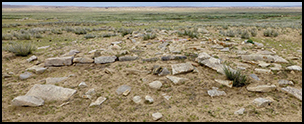Crossref Citations
This article has been cited by the following publications. This list is generated based on data provided by
Crossref.
2019.
ANNUAL BIBLIOGRAPHY.
Early China,
Vol. 42,
Issue. ,
p.
347.
Janz, Lisa
Cameron, Asa
Bukhchuluun, Dashzeveg
Odsuren, Davaakhuu
and
Dubreuil, Laure
2020.
Expanding frontier and building the Sphere in arid East Asia.
Quaternary International,
Vol. 559,
Issue. ,
p.
150.
Fenner, Jack N.
Delgermaa, Lkhagvadorj
Piper, Philip J.
Wood, Rachel
and
Stuart-Williams, Hilary
2020.
Stable isotope and radiocarbon analyses of livestock from the Mongol Empire site of Avraga, Mongolia.
Archaeological Research in Asia,
Vol. 22,
Issue. ,
p.
100181.
Honeychurch, William
Rogers, Leland
Amartuvshin, Chunag
Diimaajav, Erdenebaatar
Erdene-Ochir, Nasan-Ochir
Hall, Mark E.
and
Hrivnyak, Michelle
2021.
The earliest herders of East Asia: Examining Afanasievo entry to Central Mongolia.
Archaeological Research in Asia,
Vol. 26,
Issue. ,
p.
100264.
Wright, Joshua
2021.
Prehistoric Mongolian Archaeology in the Early 21st Century: Developments in the Steppe and Beyond.
Journal of Archaeological Research,
Vol. 29,
Issue. 3,
p.
431.
Janz, Lisa
Rosen, Arlene M.
Bukhchuluun, Dashzeveg
Odsuren, Davaakhuu
and
Petraglia, Michael D.
2021.
Zaraa Uul: An archaeological record of Pleistocene-Holocene palaeoecology in the Gobi Desert.
PLOS ONE,
Vol. 16,
Issue. 4,
p.
e0249848.
Zhao, Chao
Janz, Lisa
Bukhchuluun, Dashzeveg
and
Odsuren, Davaakhuu
2021.
Neolithic pathways in East Asia: early sedentism on the Mongolian Plateau.
Antiquity,
Vol. 95,
Issue. 379,
p.
45.
Schneider, Joan S.
Yadmaa, Tserendagva
Farquhar, Jennifer M.
and
Hadel, Patrick
2021.
Entering new territory: The results of a random-sample archaeological inventory at Ikh Nartiin Chuluu Nature Reserve, Dornogovi Aimag, Mongolia.
Archaeological Research in Asia,
Vol. 25,
Issue. ,
p.
100251.
Kenoyer, Jonathan Mark
Cameron, Asa
Bukhchuluun, Dashzeveg
Amartuvshin, Chunag
Byambatseren, Batdalai
Honeychurch, William
Dussubieux, Laure
and
Law, Randall
2022.
Carnelian beads in Mongolia: new perspectives on technology and trade.
Archaeological and Anthropological Sciences,
Vol. 14,
Issue. 1,
Rosen, Arlene
2022.
Perspectives on Public Policy in Societal-Environmental Crises.
p.
161.
Rosen, Arlene M
Janz, Lisa
Dashzeveg, Bukhchuluun
and
Odsuren, Davaakhuu
2022.
Holocene desertification, traditional ecological knowledge, and human resilience in the eastern Gobi Desert, Mongolia.
The Holocene,
Vol. 32,
Issue. 12,
p.
1462.
Rogers, Leland Liu
and
Kaestle, Frederika Ann
2022.
Analysis of mitochondrialDNAhaplogroup frequencies in the population of the slab burial mortuary culture of Mongolia (ca. 1100–300 BCE).
American Journal of Biological Anthropology,
Vol. 177,
Issue. 4,
p.
644.
Odsuren, Davaakhuu
Janz, Lisa
Fox, William
and
Bukhchuluun, Dashzeveg
2023.
Otson Tsokhio and Zuun Shovkh: the Initial Upper Palaeolithic in Eastern Mongolia.
Journal of Paleolithic Archaeology,
Vol. 6,
Issue. 1,
Dal Zovo, Cecilia
Parcero-Oubiña, César
César González-García, A.
and
Güimil-Fariña, Alejandro
2023.
Mapping human mobility and analyzing spatial memory: palimpsest landscapes of movement in the Gobi-Altai Mountains, Mongolia.
Journal of Anthropological Archaeology,
Vol. 71,
Issue. ,
p.
101516.
Janz, Lisa
2024.
Hunting, Herding, and diet breadth. A landscape based approach to niche shifting in subsistence economies (Gobi Desert).
Journal of Anthropological Archaeology,
Vol. 76,
Issue. ,
p.
101624.
Rouse, Lynne M.
Doumani Dupuy, Paula N.
Abdykanova, Aida
Brite, Elizabeth Baker
Hermes, Taylor R.
Kidd, Fiona
Luneau, Elise
Miller, Bryan K.
Radivojević, Miljana
Shnaider, Svetlana
Tabaldyev, Kubatbek
Ventresca-Miller, Alicia
and
Wright, Joshua
2024.
[Re]Integrating a dispersed agenda: advancing archaeological research in Central Eurasia.
Antiquity,
Vol. 98,
Issue. 400,
p.
1088.
Bennett, Andrew E.
Liu, Yichen
and
Fu, Qiaomei
2025.
Reconstructing the Human Population History of East Asia through Ancient Genomics.
Honeychurch, William
Fan, Rong
Rogers, Leland
Hall, Mark E.
Amartuvshin, Chunag
Byambatseren, Batdalai
Pleuger-Dreibrodt, Sarah
Khatanbaatar, Dorjpurev
Erdene, Myagmar
Houle, Jean-Luc
Cai, Dawei
Tressières, Gaëtan
Calvière-Tonasso, Laure
Schiavinato, Stéphanie
Chauvey, Lorelei
Birgel, Julie
Cruaud, Corinne
Aury, Jean-Marc
Oliveira, Pedro H.
Wincker, Patrick
and
Orlando, Ludovic
2025.
Straight from the Horse’s Mouth: Timing and Zoogeography of Domesticated Horse Arrivals in Mongolia and China.
Journal of Archaeological Method and Theory,
Vol. 32,
Issue. 1,
Pleuger-Dreibrodt, Sarah
Honeychurch, William
and
Makarewicz, Cheryl A.
2025.
Multispecies pastoralism around Delgerkhaan Uul — local practices under large scale sociocultural and political shifts between 1800 BC and 200 AD.
Archaeological and Anthropological Sciences,
Vol. 17,
Issue. 3,



